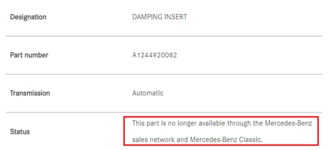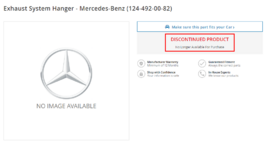One of the commonly overlooked issues by many owners are the rubber exhaust hangers that suspend the exhaust system from the bottom of the car. There are several types available, and these are covered thoroughly in other threads on this forum.
These hangers are generally made of a durable rubber material, but exposure to heat and the elements causes them to wear and let loose with regularity. All exhaust hangers should be visually inspected at least every six months, if not more regularly. They can fail with surprising rapidity.
The dual catalytic converters as used on the 500E, E500, 400E and E420 are suspended at their rear-most area from the bottom of the car by two, specialized exhaust hangers. These hangers are not used in other areas of the exhaust system, such as on the rear muffler. Thus, it is highly advised to purchase a pair of these exhaust hangers to have in reserve, for when they are needed. And this is a "when"....not an "if."
Exhaust hangers are a very small, but very important, part of the $5,000 of deferred maintenance that all E500Es carry with them daily.
Changing out these rubber catalytic converter hangers is a 30-minute job, perhaps 15 minutes if the car can be placed on a lift. This job can be done if the car is jacked up from the side (and properly supported for safety, or also driven forward or backed onto a pair of ramps.
Tools needed for this job:
Parts needed for this job:
First, suspend the car off the ground using ramps, a floor jack or a lift (as your resources allow). In my case, I backed the car onto a pair of ramps. It is probably better to drive the car forward onto the ramps rather than backing it, but I made do anyway.
Place your shop light underneath the car to illuminate the hanger/catalytic converter area.
With your floor jack, if available, place it under the catalytic converter assembly, a few inches forward of the rubber hanger area, and SLIGHTLY jack the converters up toward the bottom of the car about 0.75-1 inch. This will help take the pressure off of the rubber hangers, making them easier to remove.
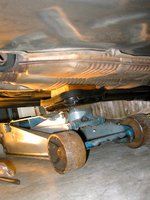

Here you can see the worn and stretched exhaust hangers, barely holding up the catalytic converters.
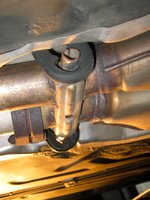
Now that the pressure is off of the lower portion of the hanger, you should be able to move it off of the catalytic converter's "hook" with your fingers. Then, use your flat-blade screwdriver to prise the hanger off of the upper hook. Then work the hanger out from the area with your fingers, as shown in the third photo below.



Next, go to your parts stock and remove the exhaust hangers.


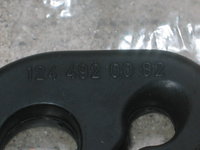

Here is what the new hangers look like, next to the old, stretched hanger.


Work the top of the new hanger onto the top-most hook on the underside of the car. Rotate the rubber hanger so that it's lowermost slot is in position near the catalytic converter's hook (the lower-most hook). Use your screwdriver, if needed, to prise the opening in the bottom of the rubber hanger onto the hook. Use your fingers to work the hanger into final position after doing this.

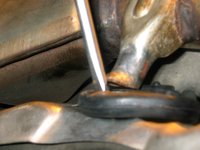
Here's what the first hanger looks like, after everything is in position. Repeat the same exact operation for the other side's hanger.

Here's what the other side's hanger looks like, in position. Then you can see the finished job, with both hangers in proper position and the catalytic converters properly suspended from the motorcar.
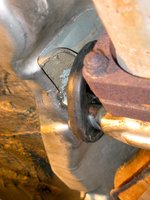

Here's a final view of the stretched and partially ripped catalytic converter hangers.

With this, you are now done with the job.
Cheers,
Gerry
These hangers are generally made of a durable rubber material, but exposure to heat and the elements causes them to wear and let loose with regularity. All exhaust hangers should be visually inspected at least every six months, if not more regularly. They can fail with surprising rapidity.
The dual catalytic converters as used on the 500E, E500, 400E and E420 are suspended at their rear-most area from the bottom of the car by two, specialized exhaust hangers. These hangers are not used in other areas of the exhaust system, such as on the rear muffler. Thus, it is highly advised to purchase a pair of these exhaust hangers to have in reserve, for when they are needed. And this is a "when"....not an "if."
Exhaust hangers are a very small, but very important, part of the $5,000 of deferred maintenance that all E500Es carry with them daily.
Changing out these rubber catalytic converter hangers is a 30-minute job, perhaps 15 minutes if the car can be placed on a lift. This job can be done if the car is jacked up from the side (and properly supported for safety, or also driven forward or backed onto a pair of ramps.
Tools needed for this job:
- Medium-sized, flat-blade screwdriver
- Floor jack (not required, but if doing on the ground can make job easier)
- Halogen or other type of shop light
Parts needed for this job:
- Rubber catalytic converter hanger, MB part number 124 492 00 82 (quantity: 2)
First, suspend the car off the ground using ramps, a floor jack or a lift (as your resources allow). In my case, I backed the car onto a pair of ramps. It is probably better to drive the car forward onto the ramps rather than backing it, but I made do anyway.
Place your shop light underneath the car to illuminate the hanger/catalytic converter area.
With your floor jack, if available, place it under the catalytic converter assembly, a few inches forward of the rubber hanger area, and SLIGHTLY jack the converters up toward the bottom of the car about 0.75-1 inch. This will help take the pressure off of the rubber hangers, making them easier to remove.


Here you can see the worn and stretched exhaust hangers, barely holding up the catalytic converters.

Now that the pressure is off of the lower portion of the hanger, you should be able to move it off of the catalytic converter's "hook" with your fingers. Then, use your flat-blade screwdriver to prise the hanger off of the upper hook. Then work the hanger out from the area with your fingers, as shown in the third photo below.



Next, go to your parts stock and remove the exhaust hangers.




Here is what the new hangers look like, next to the old, stretched hanger.


Work the top of the new hanger onto the top-most hook on the underside of the car. Rotate the rubber hanger so that it's lowermost slot is in position near the catalytic converter's hook (the lower-most hook). Use your screwdriver, if needed, to prise the opening in the bottom of the rubber hanger onto the hook. Use your fingers to work the hanger into final position after doing this.


Here's what the first hanger looks like, after everything is in position. Repeat the same exact operation for the other side's hanger.

Here's what the other side's hanger looks like, in position. Then you can see the finished job, with both hangers in proper position and the catalytic converters properly suspended from the motorcar.


Here's a final view of the stretched and partially ripped catalytic converter hangers.

With this, you are now done with the job.
Cheers,
Gerry




